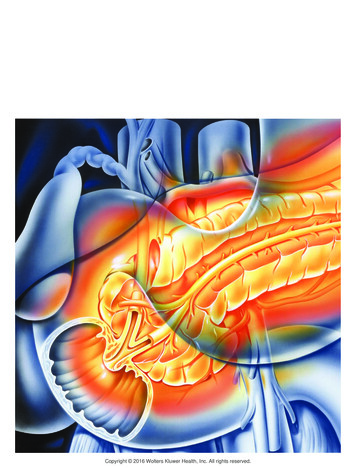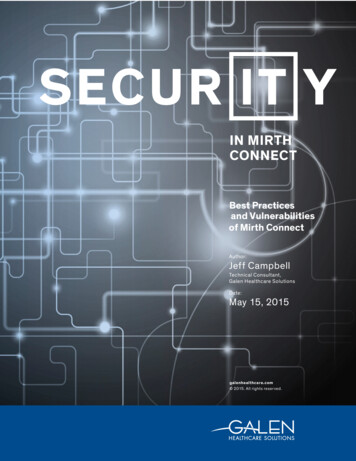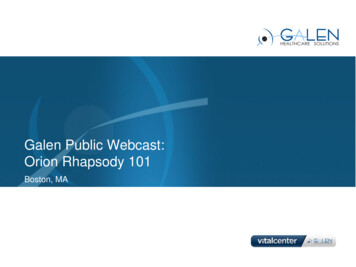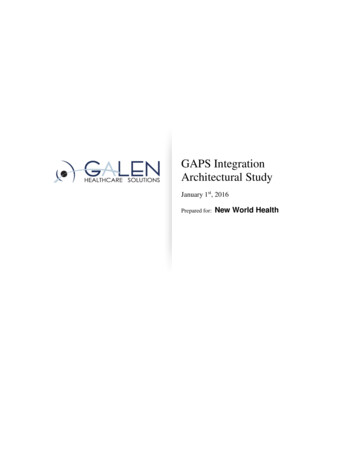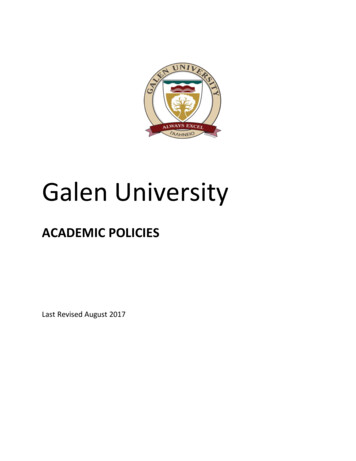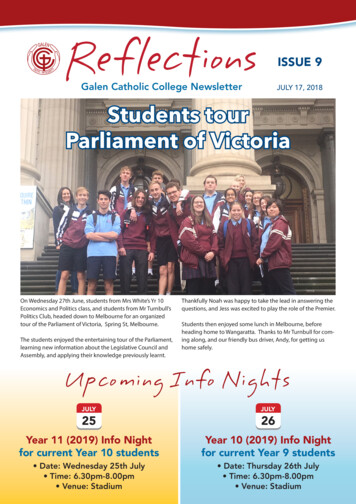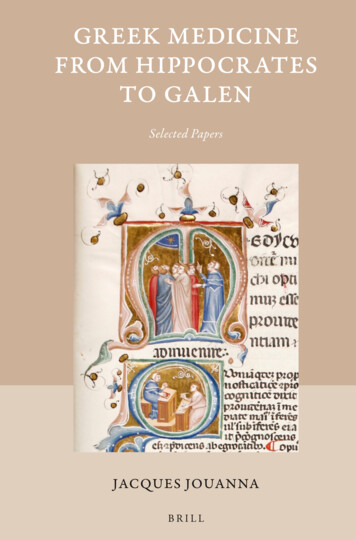
Transcription
c Copyright 2016Galen Andrew
New Techniques in Deep Representation LearningGalen AndrewA dissertationsubmitted in partial fulfillment of therequirements for the degree ofDoctor of PhilosophyUniversity of Washington2016Reading Committee:Emanuel Todorov, ChairEmily FoxCarlos GuestrinLuke ZettlemoyerProgram Authorized to Offer Degree:UW Computer Science and Engineering
University of WashingtonAbstractNew Techniques in Deep Representation LearningGalen AndrewChair of the Supervisory Committee:Associate Professor Emanuel TodorovCSE, joint with AMATHThe choice of feature representation can have a large impact on the success of a machinelearning algorithm at solving a given problem. Although human engineers employing taskspecific domain knowledge still play a key role in feature engineering, automated domainindependent algorithms, in particular methods from the area of deep learning, are provingmore and more useful on a variety of difficult tasks, including speech recognition, imageanalysis, natural language processing, and game playing. This document describes three newtechniques for automated domain-independent deep representation learning: Sequential deep neural networks (SDNN) learn representations of data that is continuously extended in time such as audio. Unlike “sliding window” neural networksapplied to such data or convolutional neural networks, SDNNs are capable of capturingtemporal patterns of arbitrary span, and can encode that discovered features shouldexhibit greater or lesser degrees of continuity through time. Deep canonical correlation analysis (DCCA) is a method to learn parametric nonlineartransformations of multiview data that capture latent shared aspects of the views sothat the learned representation of each view is maximally predictive of (and predictedby) the other. DCCA may be able to learn to represent abstract properties when thetwo views are not superficially related.
The orthant-wise limited-memory quasi-Newton algorithm (OWL-QN) can be employedto train any parametric representation mapping to produce parameters that are sparse(mostly zero), resulting in more interpretable and more compact models. If the priorassumption that parameters should be sparse is reasonable for the data source, trainingwith OWL-QN should also improve generalization.Experiments on many different tasks demonstrate that these new methods are computationallyefficient relative to existing comparable methods, and often produce representations thatyield improved performance on machine learning tasks.
TABLE OF CONTENTSPageList of Figures . . . . . . . . . . . . . . . . . . . . . . . . . . . . . . . . . . . . . . .iiiGlossary . . . . . . . . . . . . . . . . . . . . . . . . . . . . . . . . . . . . . . . . . . .ivChapter 1:Introduction . . . . . . . . . . . . . . . . . . . . . . . . . . . . . . . .1.1 Contributions and thesis overview . . . . . . . . . . . . . . . . . . . . . . . .14Chapter 2:The current state of research in deep representation learning2.1 Parameter optimization for deep representation learning models .2.2 Specialized architectures for structured data . . . . . . . . . . . .2.3 Computational considerations . . . . . . . . . . . . . . . . . . . .2.4 Conclusion . . . . . . . . . . . . . . . . . . . . . . . . . . . . . . .77142122Chapter 3:Learning deep representations for continuously extended data3.1 Continuously extended data . . . . . . . . . . . . . . . . . . . . . .3.2 The sequential restricted Boltzmann machine (SRBM) . . . . . . .3.3 The sequential deep neural network (SDNN) . . . . . . . . . . . . .3.4 Backpropagation algorithm . . . . . . . . . . . . . . . . . . . . . . .3.5 Experiments . . . . . . . . . . . . . . . . . . . . . . . . . . . . . . .3.6 Conclusion . . . . . . . . . . . . . . . . . . . . . . . . . . . . . . . .23232834364043Chapter 4:Learning deep representations for multiview data4.1 Multiview data . . . . . . . . . . . . . . . . . . . . . .4.2 Related work . . . . . . . . . . . . . . . . . . . . . . .4.3 Background: CCA, KCCA, and deep representations .4.4 Deep canonical correlation analysis (DCCA) . . . . . .4.5 Experiments . . . . . . . . . . . . . . . . . . . . . . . .454547475056i.
4.6Conclusion . . . . . . . . . . . . . . . . . . . . . . . . . . . . . . . . . . . . .63Chapter 5:Learning sparsely connected neural representation models with L1 regularization . . . . . . . . . . . . . . . . . . . . . . . . . . . . . . . .Introduction . . . . . . . . . . . . . . . . . . . . . . . . . . . . . . . . . . . .Quasi-Newton algorithms and L-BFGS . . . . . . . . . . . . . . . . . . . . .Orthant-wise limited-memory quasi-Newton (OWL-QN) for convex objectivesExperiments with convex loss . . . . . . . . . . . . . . . . . . . . . . . . . .OWL-QN for non-convex loss functions . . . . . . . . . . . . . . . . . . . . .Experiments with non-convex loss . . . . . . . . . . . . . . . . . . . . . . . .Conclusions . . . . . . . . . . . . . . . . . . . . . . . . . . . . . . . . . . . .6464686973828386Chapter 6:Conclusions . . . . . . . . . . . . . . . . . . . . . . . . . . . . . . . . .6.1 The future of representation learning . . . . . . . . . . . . . . . . . . . . . .8889Bibliography . . . . . . . . . . . . . . . . . . . . . . . . . . . . . . . . . . . . . . . .935.15.25.35.45.55.65.7Appendix A: Proof of claim in derivation of SDNN gradient . . . . . . . . . . . . . . 115Appendix B: Derivation of DCCA gradient . . . . . . . . . . . . . . . . . . . . . . . 117Appendix C: Termination of OWL-QN projected line searchii. . . . . . . . . . . . . 120
LIST OF FIGURESFigure NumberPage2.12.22.32.42.52.6Illustration of multilayer perceptron . . . . . . .The basic restricted Boltzmann machine (RBM)The basic autoencoder network. . . . . . . . . .Illustration of convolutional neural network. . .Illustration of recurrent neural network. . . . . .Long short-term memory unit . . . . . . . . . .89111517193.13.23.3Illustration of sequential restricted Boltzmann machine structure . . . . . . .Illustration of sequential deep neural network structure . . . . . . . . . . . .Sequential deep neural network performance on TIMIT . . . . . . . . . . . .3135424.14.24.34.4Illustration of deep canonical correlation analysis structureModified cube-root nonlinearity . . . . . . . . . . . . . . .Examples of left and right views of split MNIST dataset. .DCCA/KCCA comparison as representation size varies . .515558615.15.25.35.45.55.65.7Algorithmic description of OWL-QN . . . . . . . . . . . . . . . . . .Performance of L1 - and L2 -regularized models on parse reranking . .Objective value during optimization on parse reranking . . . . . . . .Comparing AlgLib’s L-BFGS with our own implementation . . . . . .Number of non-zero weights during training of parse reranking modelMNIST test set errors during training with OWL-QN. . . . . . . . . .Number of non-zero weights during training of classifier for MNIST. .72777980818485iii. . . . . . . . .graphical model. . . . . . . . . . . . . . . . . . . . . . . . . . . . . . . . . . . . . .structure. . . . . . . . . . . . . . . . . . . . .
GLOSSARYAE:AutoencoderCCA:Canonical correlation analysisCD:Contrastive divergenceCNN:Convolutional neural networkCRF:Contional random fieldDAE:Denoising autoencoderDeep canonical correlation analysisDCCA:DNN:Deep neural networkGPU:Graphics processing unitHMM:Hidden Markov modelKCCA:Kernel canonical correlation analysisL-BFGS:LSTM:Limited-memory BFGS (BroydenFletcherGoldfarbShanno)Long short-term memoryMFCCS:Mel-frequency cepstral coefficientsMLP:Multilayer perceptronMRF:Markov random fieldMT:Machine translationiv
NLP:Natural language processingNN:Neural networkOWL-QN:Orthant-wise limited-memory quasi-NewtonPCA:Principal components analysisRBF:Radial basis functionRBM:Restricted Boltzmann machineRELU:Rectified linear unitRKHS:Reproducing kernel Hilbert spaceRL:Representation learningRNN:Recurrent neural networkSDNN:SGD:Sequential deep neural networkStochastic gradient descentSRBM:Sequential restricted Boltzmann machinev
ACKNOWLEDGMENTSThe author wishes to express his sincere appreciation to the professors, colleagues andstudents with whom I have collaborated on the research presented in this thesis, and fromwhom I have learned so much, including Jianfeng Gao, Kristina Toutanova, Mark Johnson,Eric Brill, Chris Burgess, Raman Arora, Karen Livescu, Rishabh Iyer, Igor Mordatch, andEmo Todorov.This research presented here was supported by Microsoft Research (where I was employed),the University of Washington, and by grants from the NSF (IIS-0905633) and the Intel/UWISTC.vi
DEDICATIONto Kristina, the best co-parent I could imaginevii
1Chapter 1INTRODUCTIONThe ultimate success of a machine learning algorithm applied to a given task is oftendetermined at least as much by the choice of data representation (i.e., feature representation)as by the choice of algorithm or algorithm hyperparameters. A machine learning expertusually cannot achieve the best results without collaborating with a domain expert to identifywhich aspects of the problem would most fruitfully be included in the input. Yet, naturallearning systems, such as animal brains and in particular the human brain, seem to beable to determine which aspects of their high-dimensional input are worth focusing on withcomparatively little guidance. This difference in the feature representation, as much asdifferences in the “learning algorithm” employed by artificial vs. natural learning agents tomake predictions based on those features, may underlie the difficulty in creating computerlearning systems that can flexibly respond to high-dimensional sensory input and perform“hard AI” tasks, such as communicating fluently in natural language, human-level image andaudio understanding, and robot control in noisy and uncertain environments.In this thesis, we will take representation learning to mean any technique for constructinga mapping from one data representation to another, with the intention that the altered datawould be more useful as input to a machine learning algorithm. Typically the input datawould be low-level, raw and unabstracted, such as pixel intensities for visual input, or localair pressure deviation readings as measured by a set of microphones for audio. The job of arepresentation learning algorithm is to determine functions of the raw input that computehigher-level properties to aid in downstream tasks such as classification. For images, therepresentation might include edges, color or texture patches, or object components; for audio,we might have amplitude of certain frequency bands or the existence of component sounds
2from a dictionary. If the data is discrete, as in a set of independent images, the representationlearning algorithm may operate on instances independently of each other. In the case ofstreaming data like continually processed audio, the representation mapping could act as afilter, where the representation at a given time depends on the history of the signal up tothat time.Some classical dimensionality reduction techniques, such as Principle Components Analysis(PCA) [140], k-means clustering [112], and canonical correlation analysis (CCA) [77, 3] maybe considered to be forms of automatic representation learning. Such simple methods areoften useful as a preprocessing step for many learning algorithms. In the past few decades,many, many other more sophisticated techniques have been proposed for inducing usefulfeatures. To name just a few: there is manifold learning [178, 150], sparse coding [138, 100, 47],spectral clustering [159, 118], (single-layer) autoencoder networks and variations [187], andprobabilistic latent factor models of many different flavors, such as latent Dirichlet allocation(LDA) [26], sigmoid belief networks [131], and restricted Boltzmann machines (RBMs) [167].What all of the approaches just mentioned have in common is that they may be viewedas producing a single new representation “all at once”, without intermediate layers ofrepresentation. In contrast, so-called “deep” representation learning constructs featuresat multiple levels, with higher-level features constructed as functions of lower-level ones.Theoretical and empirical evidence suggests that useful and compact representations for somehard problems may require multiply nested layers of representation [73, 183]. Consideringbiological learning systems, the primary visual cortex in mammals is known to have ahierarchical organization with earlier stages of processing (area V1) identifying points, edges,and lines, which are later used to detect more complex features in area V2 [81].1 Håstadand Goldmann [66] demonstrate that there exist efficiently computable binary functions thatwould require exponentially sized circuits if the circuit depth were bounded.1The visual cortex also makes use of feedback connections, where “higher level” features can influencethe perception of “lower level” ones. Some machine learning researchers have attempted modeling suchconnections, (see, e.g., Stollenga et al. [174]), but all models in widespread use today are purely feedforward.
3Bengio et al. [20] discuss some properties we may demand of a representation learningalgorithm in order that it perform well on hard AI tasks, including expressivity (uselessinformation should be discarded), disentangling factors of variation (induced features shouldvary independently of each other), and most critically abstraction (identifying meaningful,predictive features, even if two inputs sharing some feature may be distant in the inputspace). A hierarchy of successively more abstract features enables the recognition of propertiesshared between instances that are superficially dissimilar. It promotes the re-use of featureslower in the hierarchy, increasing the efficiency of the representation, particularly when thesame representation is to be used for multiple tasks, as in transfer learning. A hierarchicalrepresentation may make adaptation to new tasks or changes in the data distribution easier, solong as most features remain identifiable and useful. Concepts that may require an impossibleamount of data to learn as functions of the raw input may be have a much simpler expressionin terms of higher level features.Representation learning algorithms that aim to create such a feature hierarchy have beenreferred to as “deep learning” algorithms, invoking the depth of the induced feature hierarchy.Many people these days equate deep learning with artificial neural networks, but the basicprinciple that more abstract features should be composed of more primitive ones applies toa much richer set of models. Probabilistic models that posit the existence of at least one“layer” of latent (unobserved) variables whose values influence the observations have beenused in statistics and machine learning for a long time, and multilayer probabilistic modelslike the deep belief network also exist. Hierarchical representation learning methods basedon such models may be appealing in that they are grounded in the theory of probabilisticreasoning, unlike neural models that involve seemingly arbitrary choices like the form of thenonlinear activation function. Unfortunately, exact inference in probabilistic models withmultiple layers of latent variables is generally intractable, and fitting their parameters todata is, if anything, more difficult.2 It is deep neural networks that have been shown to scale2The exception that proves the rule is deep belief networks, a probabilistic model with multiple layers oflatent variables which can be usefully approximated by neural networks.
4up to very high-dimensional data (such as images, with millions of pixels and millions ofinduced features) and that have empirically proven useful on so many tasks compared tonon-hierarchical approaches.In this thesis, we will be concerned with the family of deep representation learning systemsbased on artificial neural networks. As we will see, while all widely used deep RL modelsare essentially descendants of the feedforward neural network architecture known as themultilayer perceptron, there are many successful variations on the basic algorithm improvingits performance or specializing it to particular forms of data.1.1Contributions and thesis overviewIn recent years, deep neural networks have advanced the state-of-the-art on several classicallydifficult machine learning tasks, such as speech recognition [1], image and character recognition [38, 94], natural language parsing [171], language modeling [120], machine translation [14],pixels-to-controls video-game playing [123], and playing the challenging game of go [162],among others. The fact that all of the currently highest-performing systems on these tasksmake use of an induced deep feature hierarchy is itself evidence that learning multiple layersof intermediate representations is a successful general strategy for complex tasks.The details of the architectures and training methods used in all of these cases varyconsiderably. The basic idea of composing feature mappings in multiple layers is so generalthat there is a huge landscape of possible variations to explore, and different problem types maybenefit from different algorithms. For example, in image processing, convolutional networks,in which parameters are shared between feature detectors at different locations throughout theimage, are typically used to obtain the best results [94, 99]. The convolutional architectureitself has been further articulated in many ways to increase performance, including maxpooling (downsampling by retaining the maximum feature value over possibly overlappingregions) and the use of fully-connected (non-convolutional) layers before the output.To obtain optimal results on other tasks, different architectural variations and trainingtechniques are used. The field remains highly empirical and a certain amount of hands-on
5experience is necessary to be able to successfully choose from the many available tools andapply them optimally toward solving a given problem on a given computing architecture.New techniques are still being proposed at a rapid pace, and it will be a continuing empiricalquestion, as well as an art, to determine which techniques, in which combinations, obtain thebest results on any task.In the present work, we consider three learning scenarios in which there exist aspectsof the problem that we believe current deep representation learning models have not yettaken full advantage of: learning representations of continuous-time data (such as audio),learning representations of multiview data (consisting of simultaneous data from differentsensory modalities), and learning compact representation models for application on low-power,low-storage devices. Our specialized models can be used in combination with many existingtechniques.This thesis is organized as follows. In the following chapter, we will review the state ofthe art in deep representation learning, describing some of the important developments thathave led to the field’s resurgence and record-breaking performance on so many tasks.Next, we will present our first model, the sequential deep neural network (SDNN), a deeprepresentation learning algorithm developed for continuous, discretized data streams such asaudio or video. Unlike a static network, or even a convolutional network, the SDNN allowsexplicit temporal connections between corresponding components of the representation atadjacent time frames. These connections give the SDNN the ability to directly model thetendency for the components of the learned representation to exhibit continuity (or lackthereof) through time. It also enables the representation to capture aspects of th
Galen Andrew A dissertation submitted in partial ful llment of the requirements for the degree of . The current state of research in deep representation learning . . . . . . 7 . students with whom I have collaborat

